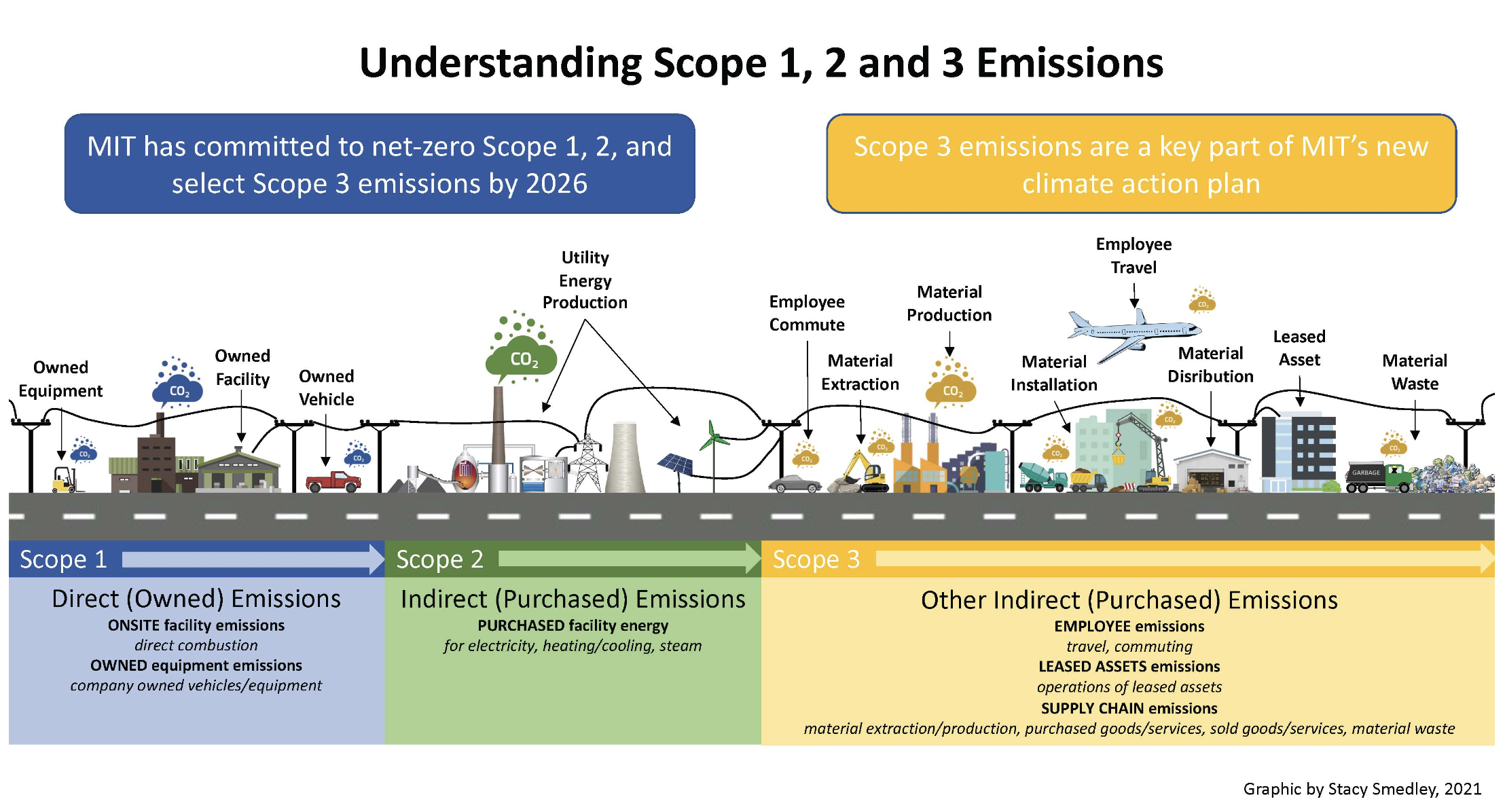Explore visualizations on MIT-sponsored travel or business travel including travel emissions versus expense, travel emissions by year, and travel emissions attributed to school area.

The MIT Office of Sustainability (MITOS) continues to gather a preliminary picture of MIT’s Scope 3, or indirect, greenhouse gas (GHG) emissions in order to inform MIT’s total GHG emissions activities (Scopes 1 + 2 + 3) and explore where strategic opportunities may exist to reduce emissions.

Since 2018, MITOS has collaborated with Jeremy Gregory, Executive Director of the MIT Climate and Sustainability Consortium and a research scientist specializing in lifecycle assessment. Gregory has worked as a MITOS Faculty Fellow to build a preliminary estimate of Scope 3 GHG emissions activities and develop methods for rapid data analysis. To understand our Scope 3 emissions MITOS has been collecting available MIT data including purchased goods and services, MIT-sponsored travel, commuting, waste and capital goods.
Using the World Resources Institute/ World Business Council for Sustainable Development GHG Protocol for Scope 3 (referred to by the organizations as “Corporate Value Chain”) framework, MIT is working to catalog the full breadth of emissions involved in operating the Institute. MIT uses the above protocol to ground the categories (for example, capital goods) which make up Scope 3 emissions and identify the owners of the data within those categories in order to collect that data regularly. The World Resources Institute/ World Business Council for Sustainable Development GHG Protocol enables MIT to convert this data into GHG emissions impact.
Visualizing Scope 3 Data
Fast Forward: MIT’s Climate Action Plan for the Decade, calls on MIT to evaluate and expand its greenhouse gas portfolio accounting to include relevant Scope 3 emission categories (e.g., purchased goods and services, sponsored MIT travel, commuting). The newly launched Scope 3 Business Travel Dashboard is a climate action planning tool that can enable users to understand the scale of MIT's travel-related Scope 3 footprint and identify opportunities for reduction.
This dashboard also includes a visualization comparing preliminary Scope 3 emissions categories with data from multiple categories with Scope 1 and 2 emissions, as well as visualizations specific to MIT-sponsored travel or business travel including travel emissions versus expense, travel emissions by year, and travel emissions attributed to school area. This dashboard is the first in a series of anticipated Scope 3 visualizations that allow users to understand the scale of MIT's Scope 3 footprint and opportunities for reduction.
Visit the MIT Scope 3 Business Travel Dashboard (Kerberos login required)
MIT is leveraging this preliminary data to identify Scope 3 reduction opportunities across scales including:
-
Business travel data is informing development of a pilot program for offsetting travel emissions
-
The School of Architecture + Planning is integrating Scope 3 data into a school-wide Climate Action Plan
-
Pilot testing in campus buildings to design out waste by generating cleaner streams of food waste and recycling for feeding circular economies
-
Promoting re-use of office and lab materials through free re-use exchange tool called MIT Rheaply. (MIT community members with a Kerberos login have access to Rheaply. Get started by logging in with your credentials.)
-
Establishing sustainable purchasing programs with vendors to reduce lifecycle GHG impacts
Air Travel Carbon Offset Program
MIT is committed to reducing its carbon footprint and mitigating climate impacts. This includes carbon emissions from travel.
Achieving this commitment requires considerable effort and a range of creative options including increasing awareness of the carbon cost associated with travel, educating our community about carbon pricing as an effective strategy for reducing climate impact, and using pooled funds to support high-impact initiatives that decrease greenhouse gas (GHG) emissions.
The initial pilot program is currently available for Institute-related air travel by faculty and staff in the MIT Sloan School of Management, School of Architecture and Planning, and the Kavli Institute for Astrophysics and Space Research. During the pilot phase, travelers at these schools and institutes can purchase carbon offsets directly through MIT’s Buy-to-Pay platform.

MIT is committed to reducing its carbon footprint and mitigating climate impacts. This includes carbon emissions from travel. Achieving this commitment requires considerable effort and a range of creative options, including this pilot program.



